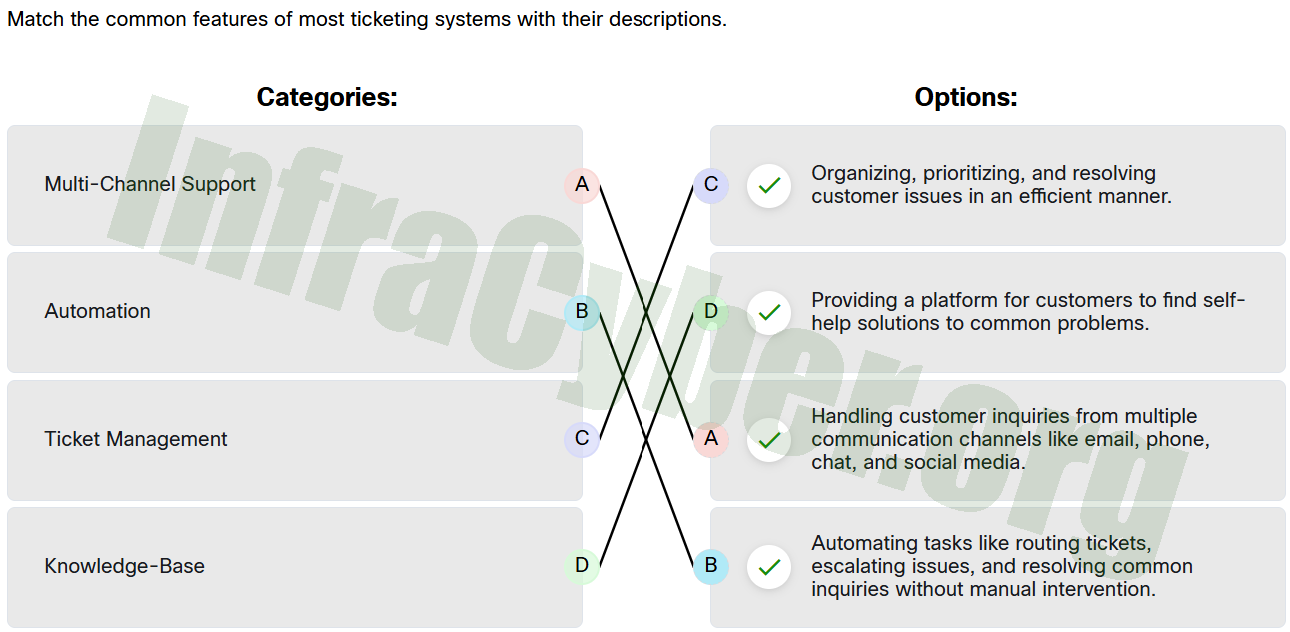Match the common features of most ticketing systems with their descriptions.

For more Questions and Answers:
1.4.2 Quiz – Module 1 Customer Service in IT Support Exam Answers
Understanding the Context:
Ticketing systems are essential tools for managing customer support and internal service requests. They enable organizations to streamline their communication processes, manage customer inquiries, and ensure efficient resolution of issues. The image you shared presents a matching exercise where the features of ticketing systems are matched with their respective descriptions.
Categories and Matched Descriptions:
-
Multi-Channel Support (Matched with C)
-
Explanation: Multi-channel support refers to the ability of a ticketing system to handle customer inquiries from various communication channels, such as email, phone, chat, and social media. In modern customer support environments, it is crucial to integrate multiple communication platforms into a single system to enhance accessibility and efficiency.
-
Why the Match is Correct: The correct match is:
-
Multi-Channel Support (A) ➔ Handling customer inquiries from multiple communication channels like email, phone, chat, and social media (C). This match is accurate because the description precisely outlines the function of multi-channel support, emphasizing the importance of integrating various platforms for effective communication.
-
-
-
Automation (Matched with B)
-
Explanation: Automation in ticketing systems involves automating repetitive tasks to improve efficiency and reduce manual workload. Common automated tasks include routing tickets to the appropriate department, prioritizing urgent issues, and providing quick responses through automated messages.
-
Why the Match is Correct: The correct match is:
-
Automation (B) ➔ Automating tasks like routing tickets, escalating issues, and resolving common inquiries without manual intervention (D). This match makes sense because the description highlights the use of automation to minimize manual tasks, thereby enhancing productivity and reducing response times.
-
-
-
Ticket Management (Matched with A)
-
Explanation: Ticket management is the core functionality of any ticketing system. It involves organizing, prioritizing, tracking, and resolving customer issues efficiently. Effective ticket management ensures that customer inquiries are handled systematically, reducing the chances of issues being overlooked.
-
Why the Match is Correct: The correct match is:
-
Ticket Management (C) ➔ Organizing, prioritizing, and resolving customer issues in an efficient manner (A). This match is accurate as it directly addresses the fundamental role of ticket management in streamlining support processes.
-
-
-
Knowledge-Base (Matched with D)
-
Explanation: A knowledge-base is an organized repository of information that customers can access to find solutions to common problems on their own. It typically includes FAQs, troubleshooting guides, and how-to articles. By providing self-help resources, the workload on support teams is significantly reduced.
-
Why the Match is Correct: The correct match is:
-
Knowledge-Base (D) ➔ Providing a platform for customers to find self-help solutions to common problems (B). This match is correct because the description encapsulates the purpose of a knowledge-base, which is to empower users with accessible, on-demand information.
-
-
Importance of These Features:
Ticketing systems are a backbone of customer support operations, particularly in IT service management (ITSM) and customer service environments. The features matched above play a crucial role in the overall effectiveness of these systems.
1. Multi-Channel Support:
-
Modern customers expect to be able to reach support through their preferred channel. Integrating these channels into a single interface improves the customer experience and ensures that no inquiry is missed, regardless of the communication method used.
2. Automation:
-
By automating routine tasks, ticketing systems reduce the manual burden on support staff. This allows human agents to focus on more complex issues while maintaining prompt responses to routine inquiries.
3. Ticket Management:
-
Effective ticket management is essential for tracking the progress of issues from initiation to resolution. Proper categorization and prioritization ensure that urgent problems are addressed promptly, minimizing downtime and customer frustration.
4. Knowledge-Base:
-
Customers increasingly prefer finding answers on their own rather than waiting for a support agent. A well-maintained knowledge-base not only improves customer satisfaction but also reduces the number of incoming tickets.
How These Features Interrelate:
These features work together to provide a seamless and efficient support experience:
-
Multi-Channel Support ensures that customer inquiries are captured, regardless of the medium.
-
Automation helps manage these inquiries efficiently by categorizing and routing them automatically.
-
Ticket Management keeps track of all inquiries systematically, allowing for clear progress tracking.
-
Knowledge-Base reduces the number of incoming tickets by enabling customers to resolve common issues independently.
Together, they form a comprehensive ticketing system that caters to both proactive and reactive support strategies.
Practical Example:
Imagine a company that offers IT support services. A customer can contact them via phone, email, or chat (Multi-Channel Support). Once a ticket is generated, the system automatically categorizes and assigns it to the relevant support team (Automation). The ticket is then managed through various stages of resolution (Ticket Management). If the customer prefers self-help, they might first explore the company’s knowledge-base to troubleshoot the issue on their own.
By leveraging these features effectively, the company can ensure that all customer issues are handled efficiently while minimizing manual intervention.
Conclusion:
The correct matches in the image accurately depict how ticketing systems are structured to manage customer support efficiently. Each feature addresses a specific aspect of the support process, and their integration ensures smooth, responsive, and organized handling of customer inquiries. Ticketing systems equipped with these features help businesses maintain high levels of customer satisfaction while optimizing their internal support workflows.